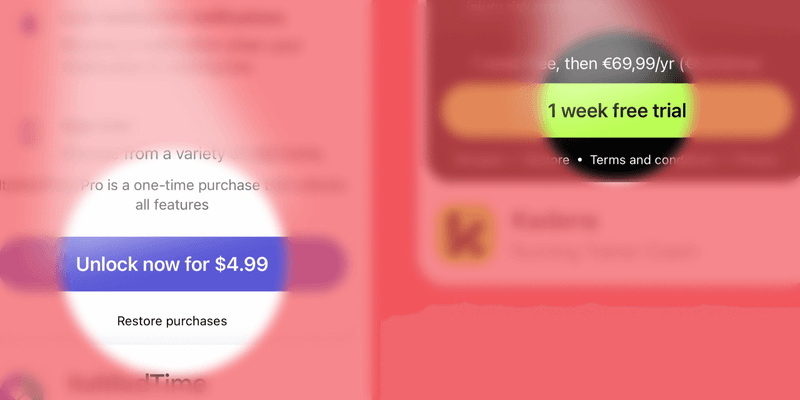There’s no shortage of advice on creating high-converting paywalls. A quick Google search yields countless recommendations from app founders and growth practitioners: add videos, include timelines, highlight testimonials. But this creates significant survivorship bias – we focus on specific success stories while ignoring the many implementations that failed.
As a result, many apps blindly copy these “best practices” only to see no improvement or even declining performance. The reality is that paywall optimization isn’t about following generic advice – it’s about understanding fundamental principles that consistently drive conversions.
Through running hundreds of paywall tests throughout my career and with Paywalls.Design, I’ve identified specific elements that reliably improve conversion rates across various apps and industries. These aren’t flashy features that make for good case studies – they’re subtle, often overlooked components that quietly but significantly influence user psychology at the critical moment of decision.
In this article, I’ll outline these proven elements that you can immediately incorporate into your paywall to boost conversion rates, backed by data rather than anecdotes.
1. Animations
Animated elements on paywalls consistently improve conversion rates. Even simple motion attracts attention in ways static designs can’t match.
Our testing shows that strategic animation works because it leverages a fundamental aspect of human psychology: we’re naturally drawn to movement. In an environment where users rapidly scan content, animation creates a pattern interrupt that momentarily focuses attention.
Effective animations don’t need to be complex:
- Subtle button pulsing
- Gentle entrance effects for pricing options
- Small movements highlighting key value propositions
The key is using animation purposefully to guide users toward conversion rather than as decoration. When implemented correctly, animated elements typically increase conversion rates by 12-18% compared to static alternatives.
2. Smart copywriting
When it comes to paywall copy, clarity trumps creativity every time. The most successful paywalls use straightforward language that immediately communicates value without making users work to understand it.
Effective paywall copy:
- States benefits directly
- Uses simple, everyday language
- Avoids industry jargon
- Focuses on user outcomes
- Maintains a consistent tone
Many product teams fall into the trap of trying to sound clever or unique with their copy. However, our extensive A/B testing shows this approach typically backfires at the payment decision point. Users encountering a paywall aren’t looking to be entertained — they’re evaluating whether your product is worth their money.
Effective paywall copy focuses on clearly articulating benefits in user-centric language. It answers the key questions (What benefit will I get? Why should I care? How will this improve my life?) without unnecessary embellishment or technical jargon.
This doesn’t mean your copy should lack personality, but that personality should never come at the expense of immediate comprehension. When users need to re-read or decipher your message, you’ve already lost valuable conversion momentum.
The most successful paywalls we’ve tested demonstrate that reducing copy complexity while maintaining benefit clarity consistently improves conversion rates across industries and price points.

Find inspiration with real paywall examples on Paywalls.com
Browse real examples at Paywalls.com: filter paywall screens by different UI elements, app category, and trending and top-growth paywalls.
3. Prominent discounts
Discount visibility directly impacts conversion rates. When offering a price reduction, displaying the discount percentage prominently on your paywall significantly outperforms designs that bury this information.
Our testing reveals that users respond strongly to clearly visible savings. The psychological principle at work is simple: people are motivated by avoiding loss (in this case, missing out on savings) even more than by potential gains. When users can immediately quantify their savings, it creates urgency and provides a compelling reason to act now rather than later.
Effective implementation means making discount percentages:
- Large and visually distinct
- Positioned above or near the pricing information
- Highlighted with contrasting colors or design elements
- Framed in terms of savings (“Save 40%”) rather than technical terms
Many apps make the mistake of treating discounts as secondary information or hiding them in smaller text. This approach diminishes the psychological impact of the offer and fails to create the sense of opportunity that drives conversions.
When users can instantly see they’re getting a special deal, it reduces hesitation and objections at the critical decision moment, making the value proposition substantially more compelling.

Additionally, if you’re offering a discount, tie it to a reason—like a holiday, an action the user took, or a special event. Give them a story that makes the discount feel earned, otherwise they’re going to feel like you’re selling to them too hard and your product is going to feel less valuable
4. Better free trial presentation
Free trials are among the most powerful conversion tools available, yet many apps dramatically underutilize them in their paywall design. Simply including a “Start Free Trial” button isn’t enough—the trial offer should be a central, recurring element throughout your paywall.
Our testing shows that explicitly highlighting the risk-free nature of a free trial across multiple touchpoints significantly boosts conversion rates. Users need reassurance that they can experience value before committing financially, and a properly emphasized free trial addresses this hesitation directly.
Effective free trial presentation includes:
- Featuring the trial offer prominently in the main headline (“Try Premium Free for 7 Days”)
- Repeating the free trial message in supporting copy
- Including visual elements that reinforce the trial concept (like timer icons or calendar graphics)
- Making the trial duration clearly visible
- Emphasizing “no commitment” or “cancel anytime” messaging
Many apps make the critical mistake of mentioning the free trial only in the call-to-action button. This fails to leverage the psychological safety that a well-communicated trial period provides throughout the decision-making process.
When users see the free trial message reinforced consistently across your paywall, it reduces perceived risk and creates a lower-stakes entry point that makes the conversion decision significantly easier.

5. Price anchoring
Price anchoring is a psychological principle that dramatically influences purchasing decisions, yet many apps implement it poorly or miss it entirely. Effectively anchoring your premium price against strategic reference points can make your offering appear significantly more valuable.
The concept is straightforward: users judge prices not in isolation but in comparison to other figures. By providing deliberate price comparisons, you create a framework that makes your target subscription price feel more reasonable or even like a bargain.
Effective price anchoring techniques include:
- Displaying a higher “regular” price alongside your current offer
- Showing the monthly equivalent when promoting annual plans (“$4.99/month billed annually”)
- Comparing subscription cost to common everyday purchases (“Less than a coffee per week”)
- Breaking down the cost to smaller, more digestible amounts (“Just 33¢ per day”)
- Highlighting the value of individual features that exceed the total subscription price
Many apps simply list their price options without providing these valuable reference points. This leaves users to create their own mental comparisons, which often work against conversion by focusing on budget constraints rather than value.
Our testing consistently shows that well-implemented price anchoring not only improves conversion rates but also drives more users toward higher-tier options and longer commitment periods by making these choices appear more advantageous in comparison.

Final thoughts
Implementing these overlooked paywall elements doesn’t require a complete redesign or extensive development resources. Often, the most impactful improvements come from subtle adjustments that align with fundamental principles of user psychology and decision-making.
What makes these elements particularly valuable is their consistent performance across different app categories and price points. While other optimization tactics might work in specific contexts, these core principles have proven reliable through thousands of tests and millions of user interactions.
The most successful subscription businesses understand that paywall optimization isn’t a one-time task but an ongoing process of refinement. Start by implementing these five elements, measure their impact, and continue iterating based on your specific audience’s response.
Remember that your paywall isn’t just a transaction point — it’s the culmination of your user’s journey and the gateway to sustained customer relationships.
By thoughtfully incorporating these often-missed elements, you can significantly improve conversions while creating a more transparent, user-friendly experience that sets the stage for long-term retention.
The difference between average and exceptional conversion rates often comes down to these seemingly small details that collectively make a powerful impact on your bottom line.

